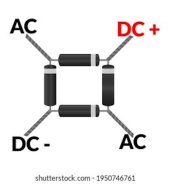Hi everyone, newbie here!
I'm wanting to connect 280W solar panels in parallel and use bridge rectifier diodes instead of common schottky blocking diodes. This is because large enough schottky's are not readily available where I live.
So, do I connect positive and negative leads coming from the panel in to rectifier AC-terminals and then leads going to MPPT-charger in to rectifier DC-terminals?
Or, like it's usually done with schottky's that only the positive lead from the panel is connected. And in this case it would be connected in to rectifiers DC positive terminal and then MPPT-charger lead in to DC negative terminal (leaving AC-terminals "empty", without connection).
Thanks for your help. Sorry my terminology might not be up to standards as I'm still learning the ropes.
I'm wanting to connect 280W solar panels in parallel and use bridge rectifier diodes instead of common schottky blocking diodes. This is because large enough schottky's are not readily available where I live.
So, do I connect positive and negative leads coming from the panel in to rectifier AC-terminals and then leads going to MPPT-charger in to rectifier DC-terminals?
Or, like it's usually done with schottky's that only the positive lead from the panel is connected. And in this case it would be connected in to rectifiers DC positive terminal and then MPPT-charger lead in to DC negative terminal (leaving AC-terminals "empty", without connection).
Thanks for your help. Sorry my terminology might not be up to standards as I'm still learning the ropes.



